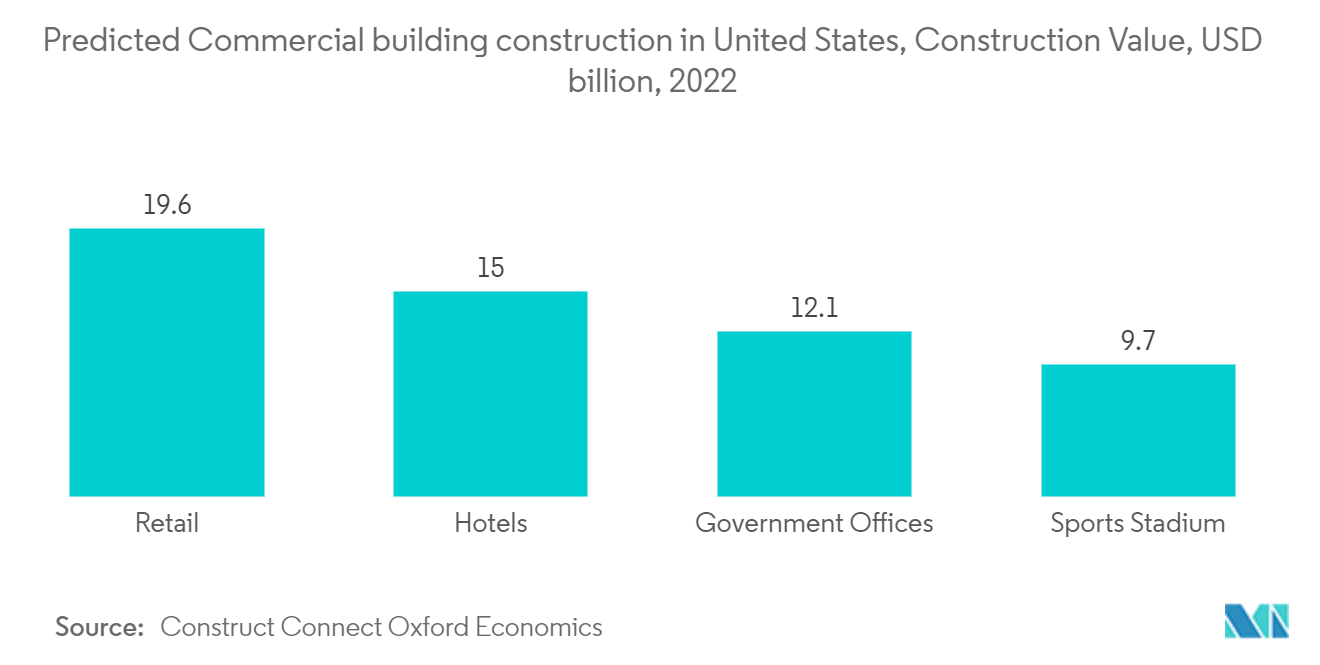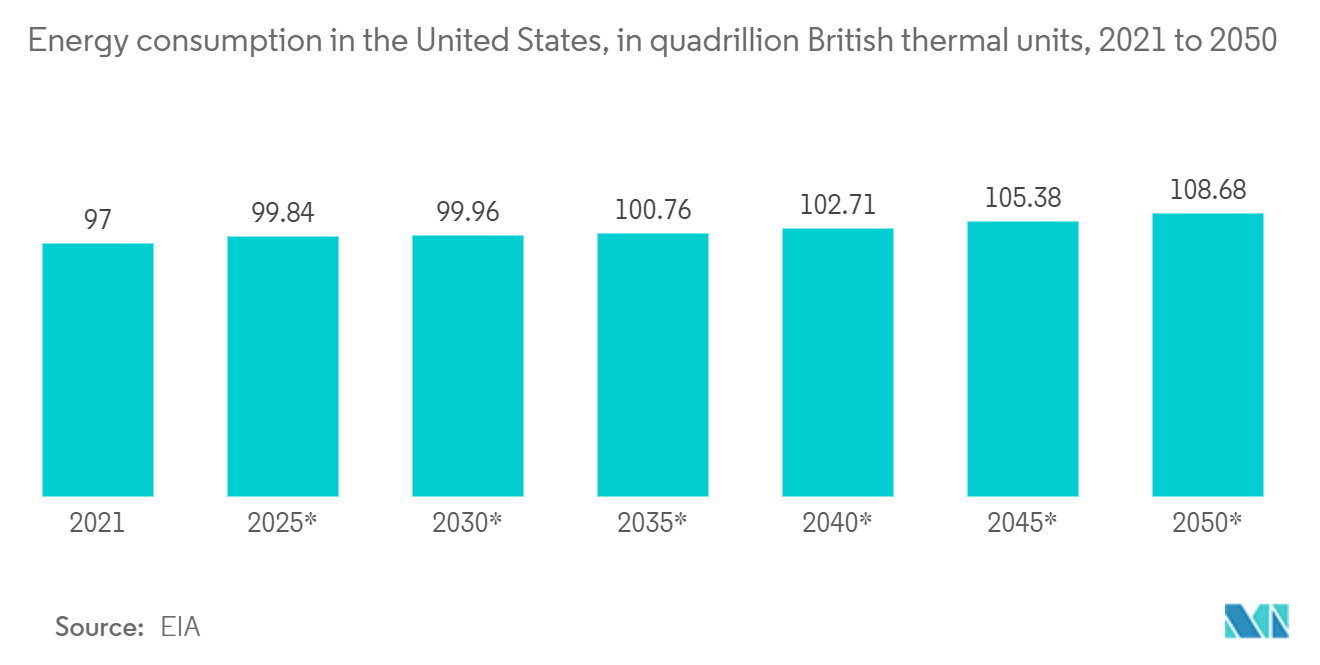Market Trends of North America Building Automation Systems Industry
Increasing Initiatives and Directives for Energy and Operational Efficiency to Drive the Market
- According to the U.S. Department of Energy, buildings are the single largest energy-consuming sector in the U.S. economy. They account for approximately 75% of the nation's electricity use and 40% of its total energy demand. The International Energy Agency says to hit global net-zero targets, all new buildings and 20% of existing buildings must be zero-carbon as soon as 2030.
- To that extent, in August 2021, the U.S. Department of Energy announced over USD 83 million in funding for 44 projects that would lower Americans' energy bills by investing in new energy-efficient building technologies, construction practices, and the U.S. building sector workforce. The department's Building Technologies Office competitively selected these projects from its Building Energy Efficiency Frontiers and Innovation Technologies funding opportunity announcement.
- Additionally, in April 2021, Johnson Controls, a global player in smart, healthy, and sustainable buildings, announced that it was awarded a USD 91 million project with the U.S. General Services Administration (GSA) to improve the facilities and energy efficiency of landmark buildings. As part of the National Deep Energy Retrofit (NDER) program, the GSA is upgrading building technologies to pursue net zero energy consumption while achieving energy goals prescribed in various federal energy acts. Buildings receiving facility improvements over the next three years comprise the New Executive Office Building (NEOB), the Ronald Reagan Building and International Trade Center (RRBITC), the Eisenhower Executive Office Building (EEOB), Jackson Place, the Winder Building, and the Civil Service Building.
- Moreover, Canada has a target to lower total greenhouse gas emissions by 40% to 45% below 2005 levels by 2030 and reach net zero by 2050. Canada is starting a program to offer financial assistance to organizations to enforce a standard to improve commercial and institutional building energy efficiency. The program is developed to get the ISO 50001 Energy Management Standard widely implemented in buildings across Canada. The standard is a structured framework to enhance energy performance by improving the efficiency of energy-intensive assets. The financial assistance is open to industry associations, utilities, indigenous organizations, and municipal, provincial, and territorial governments. The aim is to implement the standard in buildings for the 2023-2024 and 2024-2025 fiscal years.
- Further, the Government of Canada and the Federation of Canadian Municipalities (FCM) are investing in community-building retrofit projects from coast to coast. To that extent, in May 2022, the Minister of Natural Resources and the President of the Federation of Canadian Municipalities (FCM) announced an investment of over USD 3.2 million for 16 municipally led projects. This investment comes from the Green Municipal Fund's Community Buildings Retrofit (CBR) initiative, which enables communities to undertake retrofits and other upgrades to reduce emissions and enhance the energy performance of community buildings.
- Furthermore, according to Construct Connect and Oxford Economics, in 2022, the value of commercial construction by retail was to account for USD 19.64 billion, USD 14.96 billion for hotels, USD 12.05 billion for government, and USD 9.66 billion for sports stadiums. The robust investments directed toward commercial projects create a need for smart building solutions for safety.

The United States is Expected to Witness Significant Market Share
- With the rise in energy costs and environmental awareness, more and more Americans are looking for smart, connected, and automated building solutions. With the add-in capabilities of safety and alarm systems, fire safety, surveillance, and security are the most commonly installed products. IoT-enabled smart building solutions are also widely accepted in the USA. According to the Energy Impact Assessment of the U.S. Energy Information Administration, the average energy charges in the USA in 2022 were anticipated to increase by 3.9% to 14.26 cents per kWh. Furthermore, according to the EIA, the United States' energy production reached an estimated 101.02 quadrillion British thermal units (Btu) in 2021, while consumption amounted to approximately 97 Btu.
- Furthermore, in October 2021, the U.S. Department of Energy (DOE) announced USD 61 million in funding for ten pilot projects using new technology to transform thousands of homes and workplaces into cutting-edge, energy-efficient structures. These connected communities can interact with the electrical grid to optimize their energy consumption, significantly reducing carbon emissions and energy costs.
- Energy management systems are another significant revenue-generating segment under which building HVAC systems hold a considerable concentration. The United States is among the major markets for HVAC systems. According to the Energy Information Administration, or EIA, HVAC was the most energy-intensive application in commercial buildings in the United States. Building operations managers have been concerned about HVAC monitoring and management for decades, and they usually use complicated sensor networks and servers to monitor all of the data.
- Consumer spending capabilities for newer technology also augment adoption and drive vendors to launch new solutions targeting different needs. With reduced semiconductor and sensor costs, more and more companies and start-ups are working together to produce better smart building technology. The USA, especially as a hub for start-ups and with its strong financial and economic presence, has become the top spot for new technology markets such as smart building solutions.
- The governments in the region are also pushing toward adopting such innovative solutions due to the energy-saving benefits offered by such systems. The U.S. Green Building Council runs the 'LEED' program in collaboration with the Bank of America Charitable Foundation, providing support to local governments looking to adopt sustainable solutions.
- Moreover, the U.S. government is upgrading its energy grids to Advanced Metering Infrastructure (AMI) to reduce energy consumption. According to the U.S. Department of Energy, the building sector accounts for about 76% of the electricity used, resulting in a considerable amount of associated greenhouse gas (GHG) emissions, making it necessary to reduce energy consumption in buildings to comply with the national energy and environmental challenges and to decrease costs to building owners and tenants.


